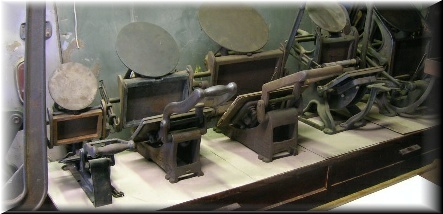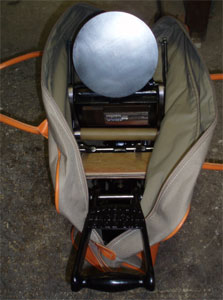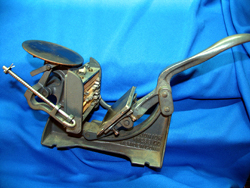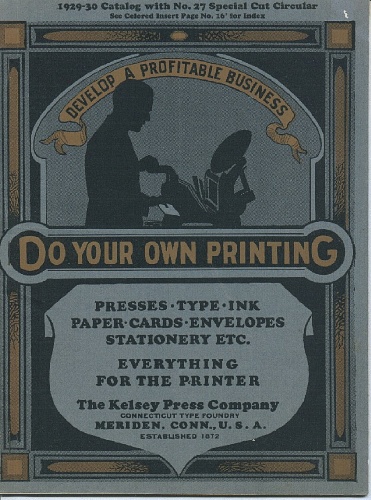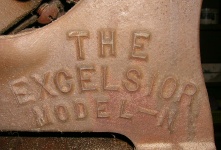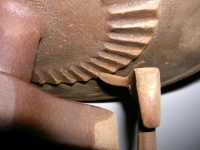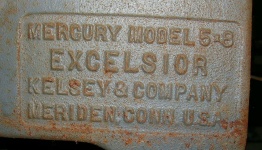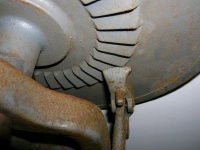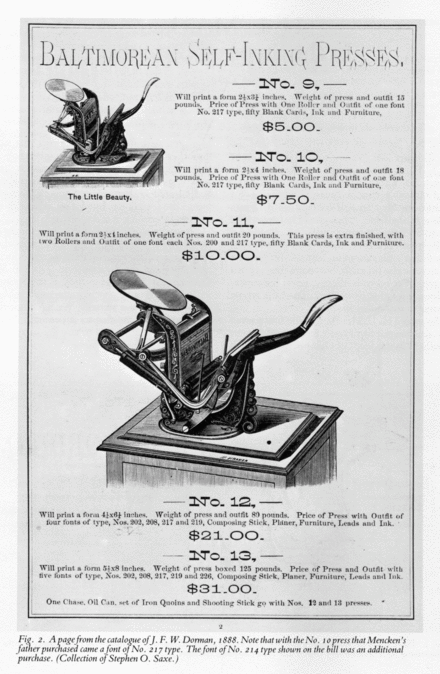
Why is this website named "ExcelsiorPress.org" when most of my content is about my own printing on my Chandler & Price, Heidelberg and Vandercook presses? Well, I named the shop when I was twelve years old (about 45 years ago) and the only press I had at the time was my little 3x5 Kelsey Excelsior. It seemed a good idea at the time, and, although I have moved on to much larger presses for my work, the old Kelsey Excelsior is the classic 'first press' every young printer should start with. And, since I did name my shop after that press, and do have a few and also now have a web presence, I get many inquiries about the Kelsey Excelsior Press. To meet that need, I am working on this little (but growing) web page to answer these questions more conveniently. The Kelsey Company manufactured
the Excelsior Press for about 100 years
(1875-1975) with minor changes. Since it was
the inspiration for my print shop name, I
have kept my original 3x5 and have collected
a few more over the years. They have come
from garages, basements and print shops. As
we encounter duplicates - as well as broken
presses and parts, we will be offering
Kelsey Presses & re-constituted starter
kits for sale from this web site as well.
~~~~~~~~~~~~~~~~~~~~~~~~~~~~~~~~~~~~~~~~~~~~
~~~~~~~~~~~~~~~~~~~~~~~~~~~~~~~~~~~~~~~~~~~~ Identifying
your
Kelsey Press: A 5x8 Mercury
is a very viable hobbyist press and,
assuming the chase and ink table are still
with it, should need only new rollers to be
fully functional. These presses currently
sell on eBay for
Do you want to
print with it, sell it or display it on a
shelf? All three are viable options. They
are interesting little machines with an a
well-documented history. The Smithsonian did
a display a few years ago entitled "A Boy
and His Press", specifically focused on the
Kelsey press and other similar presses
popular among boy printers from 1875 to
1925. After that, Kelsey was the only
serious supplier of such presses. ~~~~~~~~~~~~~~~~~~~~~~~~~~~~~~~~~~~~~~~~~~~~ top
~~~~~~~~~~~~~~~~~~~~~~~~~~~~~~~~~~~~~~~~~~~~
Using
your Kelsey Excelsior Press today...
Finding parts and supplies:
Luckily, we have three sources to
recommend:
~~~~~~~~~~~~~~~~~~~~~~~~~~~~~~~~~~~~~~~~~~~~ top
Kelsey Excelsior Press links:
Where can I buy or sell such a press? These presses have not been made new for the past 40 years, but some are being restored to like new condition.
The most effective and secure packing I've seen is to ship in a heavy-duty double-corrogated cardboard carton with a double layer of corrugated cardboard or a piece of plywood cut to fit the bottom, then insert the press into a standard trash bag, put it into the box and fill in the surrounding space with plastic peanuts and finally fill the gaps with a $5 can of expanding insulation foam (available at Home Depot, Lowes or your local hardware store). It makes a good solid package and should not add much to the weight. I received a 5x8 Kelsey that was packed this way and it was fully protected from being rolled over or dropped a foot or two. Shipping with the USPS could be more cost-effective than UPS or Fed Ex for a package of this size and weight. Compare prices. On heavier presses, I've been pleased with the independent truckers I've found on http://u-ship.com Important note! A recent sad event resulted in a press packed by UPS being broken upon arrival. If it had been packed as suggested above, this would not have happened. Replacements for presses damaged in transit are not always available. The supply of these presses is limited. Important note! update 9/1/07 - A second sad event recently resulted in a beautifully restored press otherwise properly packed and still arriving broken, leaving a very disappointed buyer and an equally disappointed seller. Quote by the seller: "I'll have to find a better way to pack the presses. I thought I did a really careful job, but I can't imagine the beating that these must take during shipment. Sigh."To prevent such a disaster for the next press shipped, I am adding one important suggestion: Bolt your press down to a base board so that it can not fall over and be crushed from the side, no matter how much the shippers toss it around. We will pack a 5x8 using these suggestions and other reasonable ideas and create a special page devoted to proper packing and shipping a 5x8 Kelsey for survival... Watch her for an update or contact me if you need to see it soon. At the Excelsior Press, we seem to have developed a pretty regular supply of presses to be restored to operation. Currently we are selling basic restored 5x8 Kelsey Presses for $800 and the occassional restored 6x10 for $1050. We have restored and sold Chandler & Price (C&P) Pillots in the past, but the supply of used Pilots to restore has seemed to dry up as the going rate for a working bona fide C&P Pilot - or even a Craftsmen or American Printing Equipment copy has reached $3,000. (November, 2008) We also have a nice 8x12 and a beautiful old 10x15 (sold) - both New Series - which we have had for years but are now available for the same price as the Pilot. Shipping or delivery can be arranged. And, of course, if you can make to Frenchtown, NJ, personalized training in the operation of any of the presses we sell can be easily arranged. And, please note that ALL proceeds of equipment, supplies or printing sold by the Excelsior Press goes to support the continued existance of this shop. It does NOT go into my pocket. Each month, we have to come up with $650 (was $600 until 2011) to pay the rent. Everything we earn in sales - and printing - goes to pay the rent and to rescue letterpress equipment so that it's here for you when you need it. For the past 20+ years, all shop expenses have come out of earnings from other sources, but since those sources can no longer support the collection, the shop must support itself in order to survive... Your purchases help keep the Excelsior Press - and this web site going. If these prices seem higher than what you see bid on eBay, consider this: Unlike the "caveat emptor" gamble of buying something that was found in a basement or garage and has been listed eBay, presses we sell come from our shop and are proven to be working - with new rollers, a supply of packing sheets and a test print made on the press prior to shipping. Note: There are some excellent press restorers (some are our friends, in fact) who are selling truly fine presses on eBay, but most of the small presses sold on eBay come with no assurance whatsoever, and many are sold lacking such basics as ink tables, chases and chase beds. Few, if any come with usable rollers. More items for sale from our collection can be found listed on our dedicated Fund Raising Page top An interesting difference between Excelsior 5x8* Models' Ink Tables * note: the 3x5's use the same ink disk. On the early series 3x5, (square handle), they are struck upward from the left. On the newer series (round handle), the striker comes down on the right. The striker dogs look different and one goes up, while the other goes down, buty they both go clockwise, so the disks are interchangeable. The 5x8's however, are different. The disks actually rotate in different directions and the driving tabs beneath the disk face in different directions. . I
recently discovered what I will refer to
as a "little known fact" about the Kelsey
Excelsior Press Ink Tables. The ink table
on the earlier models, such as our
Excelsior Model N 5x8 press, rotates in a
counter-clockwise direction, while ink
tables on the later models, such as the
Mercury 5x8 and other newer models, rotate
in a clockwise direction. The presses'
handles are also slightly different, so
that might be a hint for the press owner
looking for an ink table so that he or she
can identify this important difference.
Why is this important? While this may seem to be trivial, it is not. It is very important to owners attempting to reconstruct a press of parts these days. The ink tables are NOT interchangeable between the newer and older models of the 5x8 press. The ratchet teeth on the back of the ink table are cast to slope in different directions. Be sure to check out this feature before purchasing a replacement ink table for your press. If you select the wrong ink table, you will have to modify the striking hammer to suit the style of ink table you have installed. One strikes on the up stroke, the other strikes on the down stroke. Check out your press and get the correct ink table (if you can find one...) But why did they change? The ink tables on our larger Chandler & Price platen presses rotate in a clockwise direction. This allows the pressman to add a dab of ink to the lower left corner of the press while the type form is in the press and by the time the fresh ink is picked up by the center of the rollers - which roll over the centered form in the chase - the ink has already been spread a number of times and is less likely to fill in the type with an unsightly blob of ink. This is a very practical feature for the job printer. For the C&P pressman, the left side of the press - and ink table - is far more accessible, since the feed boar obstructs the reach on the right side... But that would happen whether rotation was clockwise or counter-clockwise, upstroke or downstroke. The difference on the Kelsey press is whether the table rotates as the rollers approach it or as they leave it. Still seems to make no difference to me. Maybe Kelsey just copied the C&P Pilot and the C&P Pilot just followed the standard set by the bigger C&P job presses... Any other ideas are welcome. top INK ROLLER HOOKS Most Kelsey presses seen today use round rod roller hooks. However, that was not always the case. The earlier 5x8 Models (patent date 1893) used a 5/16" diameter hook with a flattened end as can be seen below; Old Style Kelsey 5x8 Roller Hooks - they are different A new customer recently spent over $125 and four weeks - working with two different suppliers before she found us - trying to find the correct roller hook for her old style 5x8 Kelsey. Her press looks like the more common models we see all of the time, but it is older, and there are important differences. - Differences that many people are not aware of... This press has a patent date of 1893, and can be identified by the 4 very large flat head screws used to level the platen. It also has an extremely large hammer to drive the ink disk rotation - larger than the ones shown on our Ink Disk discussion.The chase bed is cast with wedges where newer models have pins or set screws to set the bottom position of the chase as it fits in. This chase bed is also about 6 points wider than the one used on newer models, although they are interchangeable. But the old style chase will not fit in the new style chase bed. It's just too tight. Newer chases fit into the older chase bed, so that's no problem. Otherwise, it looks a lot like the Model N,O,P,U Models we see more frequently these days. But the new style roller hooks are made of 3/8" round rod; the holes in the roller saddle of this "1893 model" are drilled for 5/16". 3/8" roller hooks might work, but would be undersized for this press' saddle. It needs 5/16" hooks - same as the larger 6x10 presses.  But these 5/16" 5x8 Roller hooks are not generally available. We have some, we may make some, but most folks making hooks these days make the 3/8" hooks made for the later model 5x8's. These older style hooks are not much in demand, and are much harder to fabricate than the simple round 3/8" hooks. The roller hooks used for this older model are made of 5/16", not 3/8" steel rod. But on this model, the hook stock was heated and flattened before being bent into position. In addition, the hooks were drilled to allow small pins to be inserted to keep the roller shafts within the hook. top Tympan Packing When the Kelsey Press was shipped from the factory, along with it came a small package of tympan packing sheets to be used on the platen. The bottom sheet was typically a hard, red, heavily calendered* pressboard. Above it would go a sheet of calendered & oiled paper, then perhaps a sheet of bond, and finally, holding it all in place - and as a place to set in your gauge pins, a larger sheet of oiled tympan which was larger and would clamp the rest beneath the bails of the platen. I have seen people use butcher paper, kraft wrapping paper and cardboard. I have even found presses packed with newspaper. But I do not recommend ad-hoc selections like these, although one sheet of newprint is fine right below the tympan sheet. They will work, and if you're on a budget or simply don't want to buy a small package of papers, that's fine. But for the best impression of type onto paper, the harder packing base is best. note: Be sure your platen is level and set to the proper distance from the bed. Don't try to make up for too large a gap with too much packing, or too little gap with less then 3 sheets of something between the type and the steel. I have larger presses and a good stock or large sheets of oiled typman, and am considering offering some for sale. No one needs much, so the packages would be small - 50-100 sheets or so. And I have sheets for the Vandercook Model 4, which could also be used for the SP-15 and I do plan to cut some down for C&P's and Kelsey Press sizes and offering them in small lots to the occassional printer. Soon I expect to advertise them or maybe sell them on eBay as "Excelsior Packing". But if you want some before I'm ready to take orders online, you can contact me and let me know of your interest. Please tell me the size of your press, how many sheets you would like to buy and what you think is a fair price for them. - Thanks. Alan * hard papers are "calendered" by rolling them between two very large, very heavy steel cylinders under a tremoundous amount of pressure, effectively removing all moisture and air and forcing the paper fibers closer together to make a very hard surface. ~~~~~~~~~~~ ~~~~~~~~~~ News! 9/05/2006: I recently met a neighbor here in Frenchtown who is a stamp collector. Back in the '80's he bought a collection of papers for the stamps that were on them. What he bought was about 1/2 of the Kelsey sales records for about 50 years! Stamps from around the world, affixed to that familiar Kelsey fold-up order blank that some of you may remember came with every Kelsey catalog and price list. Most of these old order forms have been sold to stamp collectors around the world, none of them realizing the historical record they had contained something every bit as precious as the stamps that were on them. OLD KELSEY CATALOGS News! 3/30/2010: I received a call last week from Gene Mosher - the last owner of The Kelsey Company. He has a collection of over 150 old Kelsey Catalogs - some over 100 years old! These may become availble for collectors some time in the near future. We will update this page with information as plans develop. Baltimore, Sigwalt (Chicago) and Baltimorean Presses.... American Printing History Association page on the Baltimore Presses Please contact
webmaster & printer Alan Runfeldt
with other questions.
page
last
updated
|
||||||||||||||||||||||



